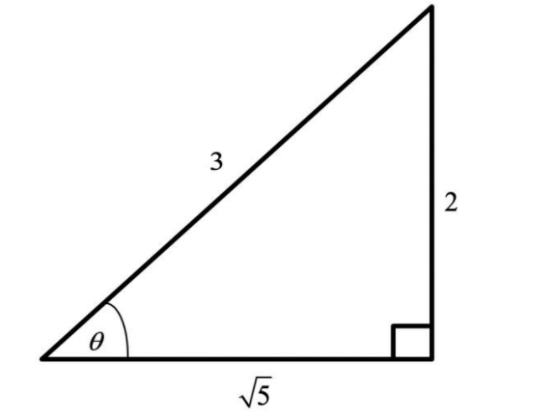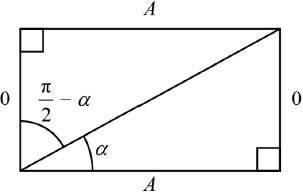Question
It is given that cosec θ \(\frac{3}{2}\) , where \(\frac{\pi }{2}< \Lambda < \frac{3\pi }{2}\) Find the exact value of cot q .
▶️Answer/Explanation
Ans:
METHOD 1

attempt to use a right angled triangle
correct placement of all three values and θ seen in the triangle
cot θ<0 (since cosec θ >o puts θ in the second quadrant)
\(cot \Theta = – \sqrt{\frac{5}{2}}\)
METHOD 2
Attempt to use 1+ cot2 θ = coses2 θ
\(1+ cot^2 \Theta = \frac{9}{4}\)
\(cot^2 \Theta = \frac{5}{4}\)
\(cot\Theta = \pm \frac{\sqrt{5}}{2}\)
cot θ<0 (since cosec θ >o puts θ in the second quadrant)
cot θ \(\frac{\sqrt{5}}{2}\)
METHOD 3
\(sin \Theta = \frac{2}{3}\)
attempt to use sin2 θ + cos2θ =1
\(\frac{4}{9}\)+cos2 θ =1
cos2 θ = \(\frac{5}{9}\)
cos θ = ± \(\frac{\sqrt{5}}{3}\)
cot θ<0 (since cosec θ >o puts θ in the second quadrant)
cos θ = \(\frac{\sqrt{5}}{3}\)
cot θ = -\(\frac{\sqrt{5}}{2}\)
Question
Show that \(\frac{{\cos A + \sin A}}{{\cos A – \sin A}} = \sec 2A + \tan 2A\) .
▶️Answer/Explanation
Markscheme
METHOD 1
\(\frac{{\cos A + \sin A}}{{\cos A – \sin A}} = \sec 2A + \tan 2A\)
consider right hand side
\(\sec 2A + \tan 2A = \frac{1}{{\cos 2A}} + \frac{{\sin 2A}}{{\cos 2A}}\) M1A1
\( = \frac{{{{\cos }^2}A + 2\sin A\cos A + {{\sin }^2}A}}{{{{\cos }^2}A – {{\sin }^2}A}}\) A1A1
Note: Award A1 for recognizing the need for single angles and A1 for recognizing \({\cos ^2}A + {\sin ^2}A = 1\) .
\( = \frac{{{{(\cos A + \sin A)}^2}}}{{(\cos A + \sin A)(\cos A – \sin A)}}\) M1A1
\( = \frac{{\cos A + \sin A}}{{\cos A – \sin A}}\) AG
METHOD 2
\(\frac{{\cos A + \sin A}}{{\cos A – \sin A}} = \frac{{{{(\cos A + \sin A)}^2}}}{{(\cos A + \sin A)(\cos A – \sin A)}}\) M1A1
\( = \frac{{{{\cos }^2}A + 2\sin A\cos A + {{\sin }^2}A}}{{{{\cos }^2}A – {{\sin }^2}A}}\) A1A1
Note: Award A1 for correct numerator and A1 for correct denominator.
\( = \frac{{1 + \sin 2A}}{{\cos 2A}}\) M1A1
\( = \sec 2A + \tan 2A\) AG
[6 marks]
Examiners report
Solutions to this question were good in general with many candidates realising that multiplying the numerator and denominator by \((\cos A + \sin A)\) might be helpful.
Question
Show that \(\cot \alpha = \tan \left( {\frac{\pi }{2} – \alpha } \right)\) for \(0 < \alpha < \frac{\pi }{2}\).
Hence find \(\int_{\tan \alpha }^{\cot \alpha } {\frac{1}{{1 + {x^2}}}{\text{d}}x,{\text{ }}0 < \alpha < \frac{\pi }{2}} \).
▶️Answer/Explanation
Markscheme
EITHER
use of a diagram and trig ratios
eg,

\(\tan \alpha = \frac{O}{A} \Rightarrow \cot \alpha = \frac{A}{O}\)
from diagram, \(\tan \left( {\frac{\pi }{2} – \alpha } \right) = \frac{A}{O}\) R1
OR
use of \(\tan \left( {\frac{\pi }{2} – \alpha } \right) = \frac{{\sin \left( {\frac{\pi }{2} – \alpha } \right)}}{{\cos \left( {\frac{\pi }{2} – \alpha } \right)}} = \frac{{\cos \alpha }}{{\sin \alpha }}\) R1
THEN
\(\cot \alpha = \tan \left( {\frac{\pi }{2} – \alpha } \right)\) AG
[1 mark]
\(\int_{\tan \alpha }^{\cot \alpha } {\frac{1}{{1 + {x^2}}}{\text{d}}x} = [\arctan x]_{\tan \alpha }^{\cot \alpha }\) (A1)
Note: Limits (or absence of such) may be ignored at this stage.
\( = \arctan (\cot \alpha ) – \arctan (\tan \alpha )\) (M1)
\( = \frac{\pi }{2} – \alpha – \alpha \) (A1)
\( = \frac{\pi }{2} – 2\alpha \) A1
[4 marks]
Examiners report
This was generally well done.
This was generally well done. Some weaker candidates tried to solve part (b) through use of a substitution, though the standard result \(\arctan x\) was well known. A small number used \(\arctan x + c\) and went on to obtain an incorrect final answer.
Question
Find the value of \(\sin \frac{\pi }{4} + \sin \frac{{3\pi }}{4} + \sin \frac{{5\pi }}{4} + \sin \frac{{7\pi }}{4} + \sin \frac{{9\pi }}{4}\).
Show that \(\frac{{1 – \cos 2x}}{{2\sin x}} \equiv \sin x,{\text{ }}x \ne k\pi \) where \(k \in \mathbb{Z}\).
Use the principle of mathematical induction to prove that
\(\sin x + \sin 3x + \ldots + \sin (2n – 1)x = \frac{{1 – \cos 2nx}}{{2\sin x}},{\text{ }}n \in {\mathbb{Z}^ + },{\text{ }}x \ne k\pi \) where \(k \in \mathbb{Z}\).
Hence or otherwise solve the equation \(\sin x + \sin 3x = \cos x\) in the interval \(0 < x < \pi \).
▶️Answer/Explanation
Markscheme
\(\sin \frac{\pi }{4} + \sin \frac{{3\pi }}{4} + \sin \frac{{5\pi }}{4} + \sin \frac{{7\pi }}{4} + \sin \frac{{9\pi }}{4} = \frac{{\sqrt 2 }}{2} + \frac{{\sqrt 2 }}{2} – \frac{{\sqrt 2 }}{2} – \frac{{\sqrt 2 }}{2} + \frac{{\sqrt 2 }}{2} = \frac{{\sqrt 2 }}{2}\) (M1)A1
Note: Award M1 for 5 equal terms with \) + \) or \( – \) signs.
[2 marks]
\(\frac{{1 – \cos 2x}}{{2\sin x}} \equiv \frac{{1 – (1 – 2{{\sin }^2}x)}}{{2\sin x}}\) M1
\( \equiv \frac{{2{{\sin }^2}x}}{{2\sin x}}\) A1
\( \equiv \sin x\) AG
[2 marks]
let \({\text{P}}(n):\sin x + \sin 3x + \ldots + \sin (2n – 1)x \equiv \frac{{1 – \cos 2nx}}{{2\sin x}}\)
if \(n = 1\)
\({\text{P}}(1):\frac{{1 – \cos 2x}}{{2\sin x}} \equiv \sin x\) which is true (as proved in part (b)) R1
assume \({\text{P}}(k)\) true, \(\sin x + \sin 3x + \ldots + \sin (2k – 1)x \equiv \frac{{1 – \cos 2kx}}{{2\sin x}}\) M1
Notes: Only award M1 if the words “assume” and “true” appear. Do not award M1 for “let \(n = k\)” only. Subsequent marks are independent of this M1.
consider \({\text{P}}(k + 1)\):
\({\text{P}}(k + 1):\sin x + \sin 3x + \ldots + \sin (2k – 1)x + \sin (2k + 1)x \equiv \frac{{1 – \cos 2(k + 1)x}}{{2\sin x}}\)
\(LHS = \sin x + \sin 3x + \ldots + \sin (2k – 1)x + \sin (2k + 1)x\) M1
\( \equiv \frac{{1 – \cos 2kx}}{{2\sin x}} + \sin (2k + 1)x\) A1
\( \equiv \frac{{1 – \cos 2kx + 2\sin x\sin (2k + 1)x}}{{2\sin x}}\)
\( \equiv \frac{{1 – \cos 2kx + 2\sin x\cos x\sin 2kx + 2{{\sin }^2}x\cos 2kx}}{{2\sin x}}\) M1
\( \equiv \frac{{1 – \left( {(1 – 2{{\sin }^2}x)\cos 2kx – \sin 2x\sin 2kx} \right)}}{{2\sin x}}\) M1
\( \equiv \frac{{1 – (\cos 2x\cos 2kx – \sin 2x\sin 2kx)}}{{2\sin x}}\) A1
\( \equiv \frac{{1 – \cos (2kx + 2x)}}{{2\sin x}}\) A1
\( \equiv \frac{{1 – \cos 2(k + 1)x}}{{2\sin x}}\)
so if true for \(n = k\) , then also true for \(n = k + 1\)
as true for \(n = 1\) then true for all \(n \in {\mathbb{Z}^ + }\) R1
Note: Accept answers using transformation formula for product of sines if steps are shown clearly.
Note: Award R1 only if candidate is awarded at least 5 marks in the previous steps.
[9 marks]
EITHER
\(\sin x + \sin 3x = \cos x \Rightarrow \frac{{1 – \cos 4x}}{{2\sin x}} = \cos x\) M1
\( \Rightarrow 1 – \cos 4x = 2\sin x\cos x,{\text{ }}(\sin x \ne 0)\) A1
\( \Rightarrow 1 – (1 – 2{\sin ^2}2x) = \sin 2x\) M1
\( \Rightarrow \sin 2x(2\sin 2x – 1) = 0\) M1
\( \Rightarrow \sin 2x = 0\) or \(\sin 2x = \frac{1}{2}\) A1
\(2x = \pi ,{\text{ }}2x = \frac{\pi }{6}\) and \(2x = \frac{{5\pi }}{6}\)
OR
\(\sin x + \sin 3x = \cos x \Rightarrow 2\sin 2x\cos x = \cos x\) M1A1
\( \Rightarrow (2\sin 2x – 1)\cos x = 0,{\text{ }}(\sin x \ne 0)\) M1A1
\( \Rightarrow \sin 2x = \frac{1}{2}\) of \(\cos x = 0\) A1
\(2x = \frac{\pi }{6},{\text{ }}2x = \frac{{5\pi }}{6}\) and \(x = \frac{\pi }{2}\)
THEN
\(\therefore x = \frac{\pi }{2},{\text{ }}x = \frac{\pi }{{12}}\) and \(x = \frac{{5\pi }}{{12}}\) A1
Note: Do not award the final A1 if extra solutions are seen.
[6 marks]
Examiners report
[N/A]
[N/A]
[N/A]
[N/A]
